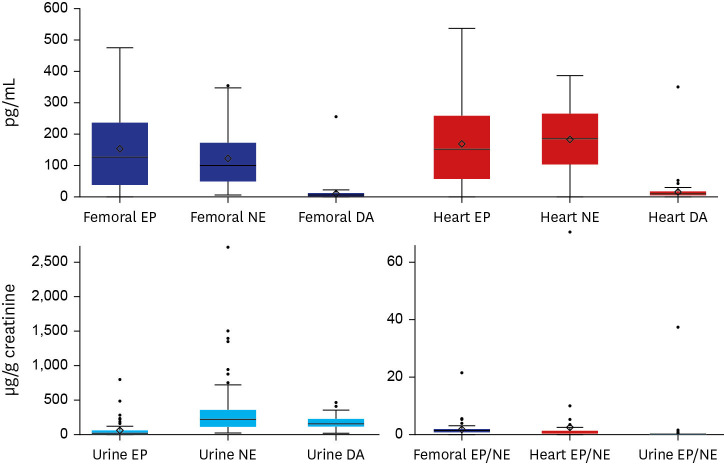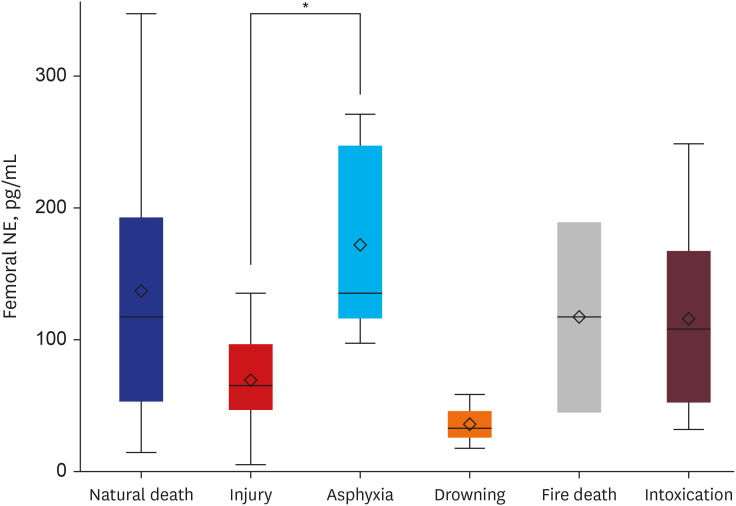J Korean Med Sci.
2023 Aug;38(32):e245. 10.3346/jkms.2023.38.e245.
Factors Influencing Postmortem Catecholamine Level and Its Correlations With Agony Time and Cause of Death in Medicolegal Autopsy
- Affiliations
-
- 1Department of Anatomy, Catholic Institute for Applied Anatomy, College of Medicine, The Catholic University of Korea, Seoul, Korea
- 2Department of Forensic Medicine, College of Medicine, The Catholic University of Korea, Seoul, Korea
- KMID: 2545197
- DOI: http://doi.org/10.3346/jkms.2023.38.e245
Abstract
- Background
Catecholamines consisting of epinephrine (EP), norepinephrine (NE), and dopamine (DA) are known as a class of chemical neurotransmitters and hormones essential for regulation of physiological processes including stress responses. Many researchers have tried to establish a relationship between postmortem catecholamine level and agony time or underlying cause of death. However, relevant studies have yielded debatable results. This study was performed to determine characteristics of catecholamine distribution in postmortem specimens with various influencing factors and to assess relationships of postmortem catecholamine levels with agony time and cause of death.
Methods
A total of 114 autopsy cases were analyzed for catecholamine levels and EP/NE ratios in femoral blood, heart blood, and urine specimens. Postmortem catecholamine levels according to sex, age, medical treatments (cardiopulmonary resuscitation [CPR] and EP injection), postmortem interval (PMI), agonal period, manner of death, and cause of death were evaluated.
Results
Close mutual relationships were noted among femoral and heart blood catecholamine levels. There was no correlation between blood and urine catecholamine levels. Catecholamine levels showed no significant differences according to sex, age, or manner of death. Heart EP and heart EP/NE ratio were significantly higher in the group with CPR. Femoral DA, heart EP, heart NE, heart DA, and urine DA were significantly increased in the group with EP injection. Urine NE and urine DA showed significant differences among PMI groups, with both increased over PMI. In correlation analysis, femoral DA and urine NE displayed weak correlations with PMI. Regarding agony time, femoral and heart DA were significantly increased in long agony group compared to those in the short agony group. With regard to the cause of death, multiple comparison analysis for major categories (natural death, injury, intoxication, asphyxia, drowning, and fire death) revealed a significant increase of femoral NE in asphyxia in comparison with injury. In subgroup analysis for the group without EP injection, femoral NE (P = 0.048), femoral DA (P = 0.039), and heart EP (P = 0.021) showed significant differences between PMI groups.
Conclusion
Results of this study have important implications for understanding postmortem catecholamine distribution and their mutual associations, influences of clinical and demographic factors, and relationships with agony time and cause of death in Korean population. Although comprehensive demonstration of catecholamine level as stress index was not possible in the present study, the assessment of postmortem catecholamine levels could be used as a supportive tool in classification of agonal status and differential diagnosis of the cause of death in particular cases. Further investigation is needed on this issue.
Keyword
Figure
Reference
-
1. Eisenhofer G, Kopin IJ, Goldstein DS. Catecholamine metabolism: a contemporary view with implications for physiology and medicine. Pharmacol Rev. 2004; 56(3):331–349. PMID: 15317907.2. Hirvonen J. Necropsy findings in fatal hypothermia cases. Forensic Sci. 1976; 8(2):155–164. PMID: 976901.3. Hirvonen J, Huttunen P. Increased urinary concentration of catecholamines in hypothermia deaths. J Forensic Sci. 1982; 27(2):264–271. PMID: 7097201.4. Hirvonen J, Huttunen P. Hypothermia markers: serum, urine and adrenal gland catecholamines in hypothermic rats given ethanol. Forensic Sci Int. 1995; 72(2):125–133. PMID: 7750868.5. Pakanen L, Kortelainen ML, Särkioja T, Porvari K. Increased adrenaline to noradrenaline ratio is a superior indicator of antemortem hypothermia compared with separate catecholamine concentrations. J Forensic Sci. 2011; 56(5):1213–1218. PMID: 21595691.6. Palmiere C, Bardy D, Letovanec I, Mangin P, Augsburger M, Ventura F, et al. Biochemical markers of fatal hypothermia. Forensic Sci Int. 2013; 226(1-3):54–61. PMID: 23313602.7. Palmiere C, Mangin P. Postmortem biochemical investigations in hypothermia fatalities. Int J Legal Med. 2013; 127(2):267–276. PMID: 22773274.8. Palmiere C, Teresiński G, Hejna P, Mangin P, Grouzmann E. Diagnostic performance of urinary metanephrines for the postmortem diagnosis of hypothermia. Forensic Sci Med Pathol. 2014; 10(4):518–525. PMID: 25034267.9. Hervet T, Teresiński G, Hejna P, Descloux E, Grouzmann E, Palmiere C. Catecholamines and their O-methylated metabolites in vitreous humor in hypothermia cases. Forensic Sci Med Pathol. 2016; 12(2):163–169. PMID: 27017494.10. Berg S, Bonte R. The catecholamine contents of cadaver blood and cerebrospinal liquor in different types of agony. Z Rechtsmed. 1973; 72(1):56–62. PMID: 4701012.11. Hausdörfer C, Pedal I, Zimmer G, Remppis A, Strobel G. Catecholamines, myofibrillary degeneration of the heart muscle and cardiac troponin T in various types of agony. Arch Kriminol. 1995; 196(1-2):46–57. PMID: 7575093.12. Kernbach-Wighton G, Sprung R, Saternus KS. On the catecholamine level in hypothermia. 11th Spring Conference of the German Society for Forensic Medicine, North Region. Potsdam Rechtsmed. 2003; 1:44–45.13. Tormey WP, Carney M, FitzGerald RJ. Catecholamines in urine after death. Forensic Sci Int. 1999; 103(1):67–71. PMID: 10464938.14. Wilke N, Janssen H, Fahrenhorst C, Hecker H, Manns MP, Brabant EG, et al. Postmortem determination of concentrations of stress hormones in various body fluids--is there a dependency between adrenaline/noradrenaline quotient, cause of death and agony time? Int J Legal Med. 2007; 121(5):385–394. PMID: 17206434.15. Berg S. Physiologico-chemical findings in cadaveric blood as the cause of death. Dtsch Z Gesamte Gerichtl Med. 1963; 54:136–149. PMID: 14082958.16. Berg S. Epinephrine and norepinephrine blood values in cases of violent death. Dtsch Z Gesamte Gerichtl Med. 1966; 57(1):179–183. PMID: 5987909.17. Kauert G. Catecholamines in Agony: Concentration Determinations in the Adrenal Medulla, Blood and, Urine From Corpses. Stuttgart, Germany: Enke;1986.18. Zhu BL, Ishikawa T, Michiue T, Li DR, Zhao D, Quan L, et al. Postmortem serum catecholamine levels in relation to the cause of death. Forensic Sci Int. 2007; 173(2-3):122–129. PMID: 17395415.19. Ishikawa T, Quan L, Michiue T, Kawamoto O, Wang Q, Chen JH, et al. Postmortem catecholamine levels in pericardial and cerebrospinal fluids with regard to the cause of death in medicolegal autopsy. Forensic Sci Int. 2013; 228(1-3):52–60. PMID: 23597740.20. Ishikawa T, Inamori-Kawamoto O, Quan L, Michiue T, Chen JH, Wang Q, et al. Postmortem urinary catecholamine levels with regard to the cause of death. Leg Med (Tokyo). 2014; 16(6):344–349. PMID: 25155919.21. Sadler DW, Pounder DJ. Urinary catecholamines as markers of hypothermia. Forensic Sci Int. 1995; 76(3):227–230. PMID: 8566925.22. Mancini C, Brown GM. Urinary catecholamines and cortisol in parasuicide. Psychiatry Res. 1992; 43(1):31–42. PMID: 1438615.23. Hirvonen J, Huttunen P. Postmortem changes in serum noradrenaline and adrenaline concentrations in rabbit and human cadavers. Int J Legal Med. 1996; 109(3):143–146. PMID: 8956989.24. Miki K, Sudo A. Effect of urine pH, storage time, and temperature on stability of catecholamines, cortisol, and creatinine. Clin Chem. 1998; 44(8 Pt 1):1759–1762. PMID: 9702972.25. Hirvonen J, Kortelainen ML, Huttunen P. Pulmonary and serum surfactant phospholipids and serum catecholamines in strangulation. An experimental study on rats. Forensic Sci Int. 1997; 90(1-2):17–24. PMID: 9438362.26. Borovsky V, Herman M, Dunphy G, Caplea A, Ely D. CO2 asphyxia increases plasma norepinephrine in rats via sympathetic nerves. Am J Physiol. 1998; 274(1):R19–R22. PMID: 9458893.27. Wu WC, Ueng JP, Chai CY. Effects of asphyxia on arterial blood pressure, formation of nitric oxide in medulla and blood parameters in the cat. Chin J Physiol. 2005; 48(1):51–56. PMID: 15973967.
- Full Text Links
- Actions
-
Cited
- CITED
-
- Close
- Share
- Similar articles
-
- Differences in the Determination of Cause and Manner of 127 Natural Death Cases by Postmortem Inspection and Autopsy
- About reform of autopsy system: focus into the limited autopsy
- Discrepancies in the Cause and Manner of Death Reported in Postmortem Inspection and Autopsy
- The Realities of Postmortem Investigation and Examination in Chungju, Eumseong Provinces
- Changes in Medicolegal Autopsy Rates in Korea between 2016 and 2020



